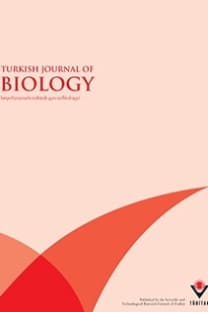Genotoxic, cytotoxic, and apoptotic effects of crude extract of Usnea filipendula Stirt. in vitro
Usnea filipendula, breast cancer, cell death, apoptosis, DNA damage
Genotoxic, cytotoxic, and apoptotic effects of crude extract of Usnea filipendula Stirt. in vitro
Usnea filipendula, breast cancer, cell death, apoptosis, DNA damage,
___
- Andreotti PE, Cree IA, Kurbacher CM, Hartmann DM, Linder D, Harel G, Gleiberman I, Caruso PA, Ricks SH, Untch M (1995). Chemosensitivity testing of human tumors using a microplate adenosine triphosphate luminescence assay: clinical correlation for cisplatin resistance of ovarian carcinoma. Cancer Res 55: 5276–5282.
- Ari F, Aztopal N, Oran S, Bozdemir S, Celikler S, Ozturk S, Ulukaya E (2014a). Parmelia sulcata Taylor and Usnea filipendula Stirt. induce apoptosis-like cell death and DNA damage in cancer cells. Cell Proliferation doi: 10.1111/cpr.12123.
- Ari F, CeliklerS, Oran S, Balikci N, Ozturk S, Ozel MZ, Ozyurt D, Ulukaya E (2014b). Genotoxic, cytotoxic and apoptotic effects of Hypogymnia physodes (L.) Nyl. on breast cancer cells. Environmental Toxicology 29: 804–813.
- Ari F, Ulukaya E, Oran S, Celikler S, Ozturk S, Ozel MZ (2014c). Promising anticancer activity of a lichen, Parmelia sulcata Taylor, against breast cancer cell lines and genotoxic effect on human lymphocytes. Cythotechnology doi: 10.1007/s10616- 014-9713-4.
- Bačkorová M, Bačkor M, Mikeš J, Jendželovsky R, Fedoročko P (2011). Variable responses of different human cancer cells to the lichen compounds parietin, atranorin, usnic acid and gyrophoric acid. Toxicology in Vitro 25: 37–44.
- Benn PA, Perle MA (1992). Chromosome staining and banding techniques. In: Rooney DE, Czepulkowsky BH, editors. Human Cytogenetics: A Practical Approach. 2nd ed. Oxford, UK: IRL Press, pp. 7–83.
- Bonassi S, Fenech M, Lando C (2001). Human micronucleus project: International database comparison for results with the cytokinesis block micronucleus assay in human lymphocytes: Effect of laboratory protocol, scoring criteria, and host factors on the frequency of micronuclei. Environ Mol Mutagen 37: 31–45.
- Brodo IM, Sharnoff SD, Sharnoff S (2001). Lichens of North America. 1st ed. New Haven, USA: Yale University Press.
- Ceker S, Orhan F, Kizil HE, Alpsoy L, Gulluce M, Aslan A, Agar G (2013). Genotoxic and antigenotoxic potentials of two Usnea species. Toxicol Ind Health doi: 10.1177/0748233713485889.
- Cevatemre B, Ari F, Sarimahmut M, Oral AY, Dere E, Kacar O, Adiguzel Z, Acilan C, Ulukaya E (2013). Combination of fenretinide and indole-3-carbinol results in synergistic cytotoxic activity inducing apoptosis against human breast cancer cells in vitro. Anticancer Drugs 24: 577–586.
- Fenech M (2000). The in vitro micronucleus technique. Mutat Res 455: 81–95.
- Gown AM, Willingham MC (2002). Improved detection of apoptotic cells in archival paraffin sections: immunohistochemistry using antibodies to cleaved caspase 3. J Histochem Cytochem 50: 449–454.
- IPCS (1985). Guide to Short Term Tests for Detecting Mutagenic and Carcinogenic Chemicals. 1st ed. Geneva, Italy: World Health Organization.
- Mann J (2002). Natural products in cancer chemotherapy: past, present and future. Nature Reviews. Cancer 2: 143–148.
- Manojlović N, Ranković B, Kosanić M, Vasiljević P, Stanojković T (2012). Chemical composition of three Parmelia lichens and antioxidant, antimicrobial and cytotoxic activities of some their major metabolites. Phytomedicine 19: 1166–1172.
- Mitrović T, Stamenković S, Cvetković V, Tośić S, Stanković M, Radojević I, Stefanović O, Ljiljana Č, Dragana Ð, Ćurčić M, et al. (2011). Antioxidant, antimicrobial and antiproliferative activities of five lichen species. Int J Mol Sci 12: 5428–5448.
- Molnar K, Farkas E (2010). Current results on biological activities of lichen secondary metabolites: a Review. Z Naturforsch C 65: 157–173.
- Müller K (2001). Pharmaceutically relevant metabolites from lichens. Appl Microbiol Biotechnol 56: 9–16.
- Oksanen I (2006). Ecological and biotechnological aspects of lichens. Appl Microbiol Biotechnol 73: 723–734.
- Park SJ, Wu CH, Gordon JD, Zhong X, Emami A, Safa AR (2004). Taxol induces caspase-10-dependent apoptosis. JBC 279: 51057–51067.
- Porter AG, Janicke RU (1999). Emerging roles of caspase-3 in apoptosis. Cell Death Differ 6: 99–104.
- Purvis OW, Coppins BJ, Hawskworth DL, James PW, Moore DM (1994). The Lichen Flora of Great Britain and Ireland. 2nd ed. London, UK: Natural History Museum Publications in association with The British Lichen Society.
- Russo A, Caggia S, Piovano M, Garbariano J, Cardile V (2012). Effect of vicanicin and protolichesterinic acid on human prostate cancer cells: role of Hsp70 protein. Chem Biol Interact 195: 1–10.
- Singh NP, McCoy MT, Tice RR, Schneider EL (1988). A simple technique for quantitation of low levels of DNA damage in individual cells. Exp Cell Res 175: 184–191.
- Singh N, Nambiar D, Kale RK, Singh RP (2013). Usnic acid inhibits growth and induces cell cycle arrest and apoptosis in human lung carcinoma A549 cells. Nutr Cancer 65 Suppl 1: 36–43.
- Sommers CL, Walker-Jones D, Heckford SE, Worland P, Valverius E, Clark R, McCormick F, Stampfer M, Abularach S, Gelmann EP (1989). Vimentin rather than keratin expression in some hormone-independent breast cancer cell lines and in oncogene-transformed mammary epithelial cells. Cancer Res 49: 4258–4263.
- Ulukaya E, Ozdikicioglu F, Oral AY, Demirci M (2008). The MTT assay yields a relatively lower result of growth inhibition than the ATP assay depending on the chemotherapeutic drugs tested. Toxicology In Vitro 22: 232–239.
- Wirth W (1995). Die Flechten Baden-Württembergs. Teil 1-2. 1st ed. Stuttgart, Germany: Ulmer (in German).
- ISSN: 1300-0152
- Yayın Aralığı: 6
- Yayıncı: TÜBİTAK
Djanan VEJSELOVA, Hatice Mehtap KUTLU, Gökhan KUŞ, Selda KABADERE, Ruhi UYAR
Failure of immunological cells to eradicate tumor and cancer cells: an overview
Rohit SHARMA, Daizee TALUKDAR, Parth MALIK, Tapan Kumar MUKHERJEE
Pınar OBAKAN, Gizem ALKURT, Betsi KÖSE, Ajda ÇOKER GÜRKAN, Elif Damla ARISAN, Deniz COŞKUN, Zeynep Narçin ÜNSAL
Apoorva PRABHU, Prerana VENKAT, Bharath GAJARAJ, Varalakshmi KILINGAR NADUMANE
Triumph or tragedy: progress in cancer
Ayşe Şebnem ERENLER, Hikmet GEÇKİL
Sabire KARAÇALI, Savaş İZZETOĞLU, Remziye DEVECİ
The role of ABC transporters in anticancer drug transport
Loss of heterozygosity in ING3 and ING5 genes in breast cancer
Esra GÜNDÜZ, Gökhan NAS, Muradiye ACAR, Eyyüp ÜÇTEPE
Ali AYDIN, Nesrin KORKMAZ, Şaban TEKİN, Ahmet KARADAĞ
